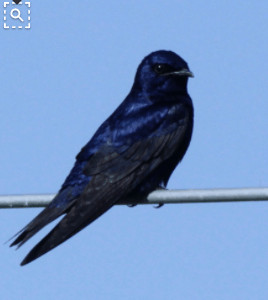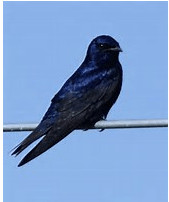An  An Adult Male Purple Martin
An Adult Male Purple Martin
Wings and Roots
If you ask what I like best about purple martins, I’d reply, “It’s how these birds have wings and roots.”
One of the joys of my rural life is the six months yearly the martins spend as my guests. These migratory birds, members of the swallow family, first arrive in Louisiana in February. Two months later, they begin building nests, and by June, the first eggs hatch. The baby birds are flying by July, and the entire colony will be gone by August.
When you understand their history and habits, you’ll grasp why I love them. Long before my ancestors came to Louisiana, Native Americans had colonized them after discovering how they devoured mosquitoes by the thousands. The Indians hung birdhouses made from dried gourds attracting these birds, which seemed to prefer living near humans.
Early pioneers also adopted these birds, and martin boxes and gourds were common around early dwellings. This love affair between humans and martins has continued as people expectantly await their arrival each spring.
If you ask most martin landlords what they love best about the birds, the answer is usually, “Their singing is beautiful.”
It’s hard to describe their song. I’ve heard it said in so many ways:
“A bubbling sound going up and down.”
“A happy song.”
“That singing as they gargle creek water and grit their teeth,” was how one older woman explained it.
Regardless of the description, it’s a song to love. Coming outside on a spring morning and hearing their playful singing, I’m happy knowing they’ve paid me the honor of spending part of the year with my family.
The hatched babies quickly grow, “feather up,” and are soon making their first tentative flights. Last year, during this time when the young are very susceptible to predators, I found a squawking baby on the ground. Before our cat could find it, I scooped the trembling bird up.
Opening my hands, I tossed the young bird into the air. It struggled and flew a short distance. Chasing it down, I caught the bird and tossed it again into the air. This time it flew much further before landing among high grass in our field. I left it there, hoping for the best.
Standing there is when I thought about my youngest son, Terry.
He is leaving within a few weeks for a summer in Southern Central Asia. He’ll be hiking along the historic rivers and foothills of the Himalayas in this remote and fascinating part of the world.
Just as I’ve tossed the martin in the air, Terry’s mother and I are doing the same for him. We trust the Lord, as well as this young man we’ve raised. From my own Asian trips, I’ve learned you never come back the same. Seeing the vast world and its great poverty changes Americans—as it should.
I know he will come back different—stronger, wiser, and looking at his own world differently.
He’ll even look at Wal -Mart differently.
Talking to others after Third World trips, they invariably bring the conversation to this statement: “I’ll never be able to walk down a crowded aisle at Wal-Mart again without thinking how the rest of the world lives.” Often they’ll mention the cereal section, while others mention the pet care aisles. Always, they emotionally put it in the context of the world’s great needs versus our own abundance.
Terry will feel that too. Just like my new flying birds, he’s going on a long journey from which one never returns to earth quite the same.
As June drifts by, all of the young birds leave the nest. The sky is now filled with martins everywhere, the young birds joining their parents in flight. They soar in the wind, and it is obvious they’re enjoying doing what they were born to do.
Watching their flight, I understand why men in earlier times attempted building flying machines. We humans are always subconsciously jealous when we see a soaring bird. King David’s words express this, “Oh, that I had wings of a dove! I would fly away and be at rest.” (Psalms 55:6)
Watching these young birds fly, the sad thought hits me as to how soon they’ll all be gone. One morning soon, probably within a month, I’ll walk outside to enjoy their singing and flying, only to find the sky is silent, and my birds gone.
I recall the previous February when the first two martin scouts arrived on a cold rainy day. I was surprised seeing them this early in such bad weather. The pair stayed throughout the day huddled on the box ledge. Then, as abruptly as they had appeared, they disappeared.
However, I knew they would eventually be back. Sure enough, within a week they were back with their entire colony.
Martins spend their winters in Brazil, nesting in hollow trees and living among the great expanse of the Amazon jungle. Sometime after the first of the year, as their instincts tell them the time is right, they begin flying in small groups northward.
Ornithologists believe they fly in collections of three or four to avoid entire colonies being wiped out in storms over the Gulf of Mexico. Following their long journey across the sea, they reach mainland North America. Upon arrival, they regroup into large flocks near bodies of water, replenishing and resting after this exhausting flight.
Shortly after grouping up in these huge colonies along the southern coast, the martin scouts head back to the exact site of the previous year’s nesting site, which is the place of birth for most of the colony.
There is some difference of opinion concerning how the scouts travel to and from the nesting site. Some speculate they navigate to their homes by the position of the stars. However, their unerring travel, even in overcast weather, raises questions concerning that theory. It’s enough to say that they have a unique inner instinct honing in on their birthplace.
To me, the marvelous instinct possessed by these birds is a clear indication of a Master Designer. I always think of their Creator, when these birds faithfully return to their home in my yard. The words of my grandfather echo, “It’d be hard to study birds and be an atheist.”
Watching their yearly arrival, I’m reminded how these birds have both wings and roots.
Wings carrying them on a long round trip journey past the equator and back, and roots bringing them home—unerringly each spring to the same box in my yard from which they were hatched.
Wings and roots. Two things that are good to have.
These are two things I’ve tried giving each of my older boys. It’s something I’m trying to instill in my youngest son, Terry, as he begins his journey nearly halfway around the world.
I compare the two trips mileage-wise. Terry’s journey will cover about eight thousand miles. It’s ironic that some martins, those commuting from Brazil to their extreme breeding range in Southern Canada, will travel about the same distance—eight thousand miles of flight.
Back at my bird boxes, I watch the martins flying about and think about their long upcoming journey. Each day, they spend less time around the bird boxes as the adult martins take the young birds on longer flights in preparation for the challenging journey ahead. As each day’s flights lengthen, it is clear that soon I’ll walk outside one morning to find the noisy singing I love so much will be gone.
It’s always a sad summer day when the martins have left, knowing I won’t see them again until February. However, at the same time I’m happy having enjoyed another year with these friends. I remind myself they are doing what they were born to do—leaving the nest flying high and far. Even though I’d like to keep them year round, I’d never deny them the freedom of their long adventure across the ocean between two continents.
Pondering how quiet it will be when these birds are gone, I think about how each of our boys did what children are supposed to do—they grew up and left home. Terry is the latest—and last one to do this. Only yesterday, he was small—just learning to fly—as I taught him how to stand in the batter’s box.
Now he is a six-foot-four inch grown man seemingly flying on his own. He’s a long ways from that eight-year-old who proudly announced his life’s goals: “I’m going to grow up and play for the Houston Astros—or drive a Little Debbie’s truck.”
Once again, I hear the song of the martins as the young birds learn the joy of soaring and diving. Then, I see—this time in my mind—the young martins, silhouetted against the sky, making their first long journey across the ocean. Through both clear blue skies, as well as in the midst of storms, they fly on, guided by the stars and the instinctive internal compass God has placed within their tiny bodies.
Crossing the vast ocean through a strong wind mixed with fog and rain, the young martins near complete exhaustion and seem ready to fall from the sky. However, one of the mature birds, a long-time veteran of this trip, flies nearer and silently wills the young birds to continue on. Then through a break in the clouds, the coast of South America looms below. They’ve made it—their first trip to their winter home.
Thinking of Terry—and where he is headed, I’m reminded that the best, happiest, and safest place to be is in the center of God’s will. This is all I can ask from God—for Him to lead my son into this special place in His will, wherever that may be.
Finally, one last time before going inside, I watch the younger martins gathered on the electrical line, readying for their big flight.
Just as I would never stop these birds from going where God, through instinct, has sent them, I know I would not stop my son, or any of the special young people I know and love, from their journey in finding God’s will for their lives.
It’s nearly dark now and walking back inside the house, I’m happy—knowing that at least for today, I have my martins—and son—to enjoy being with..
Happy that they have wings,
and also happy they have roots.
 Creekbank Stories Curt Iles, Storyteller
Creekbank Stories Curt Iles, Storyteller

